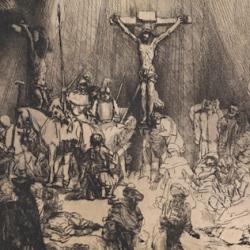In Raymund Schwager’s dramatic analysis of the atonement, Jesus comes proclaiming the kingdom of His good Father, meets rejection and begins to warn of judgment, and then, in a surprising twist, Himself goes to judgment. Jesus’ subjection to judgment does not relieve His opponents of judgment. On the contrary, they are judged just as they subject Jesus to judgment.
This is not what they thought they were doing, but “there was a great gulf between their evaluation of themselves and their actual activity. They thought that they were only (with right on their side) judging Jesus, and not themselves, and it escaped their notice that their judgment of him was in truth a ganging together against him. . . . Those judging intended to judge another and not themselves.” Their self-evaluation is shown to be “self-deception, by which they only shifted their own guilt” (117).
The false accusations against Jesus disclose the truth that the accusers don’t recognize: “The judgment on Jesus and the use of ridicule against him are . . . to be read as utterances which indirectly betray a truth about those responsible for these actions. They (and not the accused) are the ones who in fact blaspheme and who want to help others (in words), but cannot help themselves (by deeds). The self-deception is made complete above all in their cooperation, or better the ganging up, on the one, in which the false judgments of individuals mutual confirm one another and thus gain the appearance of factual objectivity. The one who is declared to be guilty, a blasphemer, serves the others as a scapegoat and gives to their kingdom of lies that appearance of peace and stability which every kingdom needs, even Satan’s . . . in order to be able to continue” (117).
Jesus’ intentions and judgments were quite different: “He allowed himself to be drawn into the process of self-judgment of his adversaries, in order, through participation in their lot, to open up for them from the inside another way out of their diabolical circle and hence a new path to salvation. He did not pay back the lying judgment and violent attack with the same coin, but he turned around the intensified evil and gave it back as love redoubled. He made of himself a gift to those who judged him and burdened him with their guilt.” He didn’t reimburse the Father for sins, but acted “in the place of those who should have welcomed the kingdom, but who from the beginning rejected it.” He allowed sinners to shift their actions to Him, to make Him scapegoat, “in order from within to open up this world once more to the Father” (117-8).
Schwager argues that this means that the Father did not hand the Son over “because he wanted to judge him and punish him in the place of sinners. The judgment did not start from God but from humankind, and the will of the Father was only that the Son should follow sinners to the very end and share their abandonment, in order thus to make possible for them again a conversion from the world of hardened hearts and distance from God” (118).











